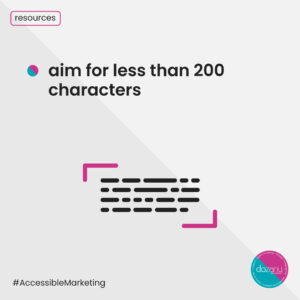Adding image descriptions to your social media posts is a quick way to ensure inclusive and accessible content for your entire audience. Here are our top 5 tips for writing image descriptions!
But first… what is alt text and is it the same as an image description? Alt text tells people what the basic details are in your image. If an image fails to load, alt text will display in its place. Search engines also index alt text information and use it to determine search engine ratings.
An image description gives more information than alt text and allows someone to learn more about what is in the image. Image descriptions should be clear and descriptive in explaining the visual content.
As well as using alt text, include your image description in the body of your text. This ensures your image description is accessible to everyone, regardless of whether they use a screen reader.
If someone is pinning the image to Pinterest, the alt text is what will display as the image description. Alt text is also useful for images with decorative text that may be difficult to see, like a signature or logo. We recommend the format [Image Description: ] to keep things clear and easy to access!
dozanü’s top 5 tips for writing image descriptions:
- Aim for under 200 characters.
- Describe facial expressions, for example “The person has a focused expression on their face.”
- Avoid sight-related terms, such as: “you can see a car,” or, “\a car is visible.”
- If an image has text in it, make sure to write out the image text verbatim as alt text.
- Use proper spelling, capitalization, spacing, and grammar.
The Perkins School for the Blind published a post on how to write image descriptions for the blind and visually impaired, and did a round up of features of an image to describe. These include:
- Placement of objects in image
- Image style (painting, graph)
- Colors
- Names of people
- Clothes (if they are an important detail)
- Animals
- Placement of text
- Emotions, such as smiling
- Surroundings
Likewise, there are some things that should be left out. These include:
- Descriptions of colors- no need to describe what red looks like
- Obvious details such as someone having two eyes, a nose, and a mouth
- Details that are not the focus of the picture
- Overly poetic or detailed descriptions
- Emoji
- Multiple punctuation marks
Once you’ve got all these items checked off the list, you can be sure to reach a bigger audience!



